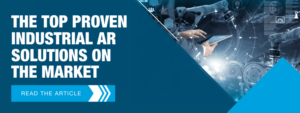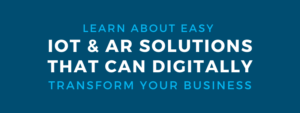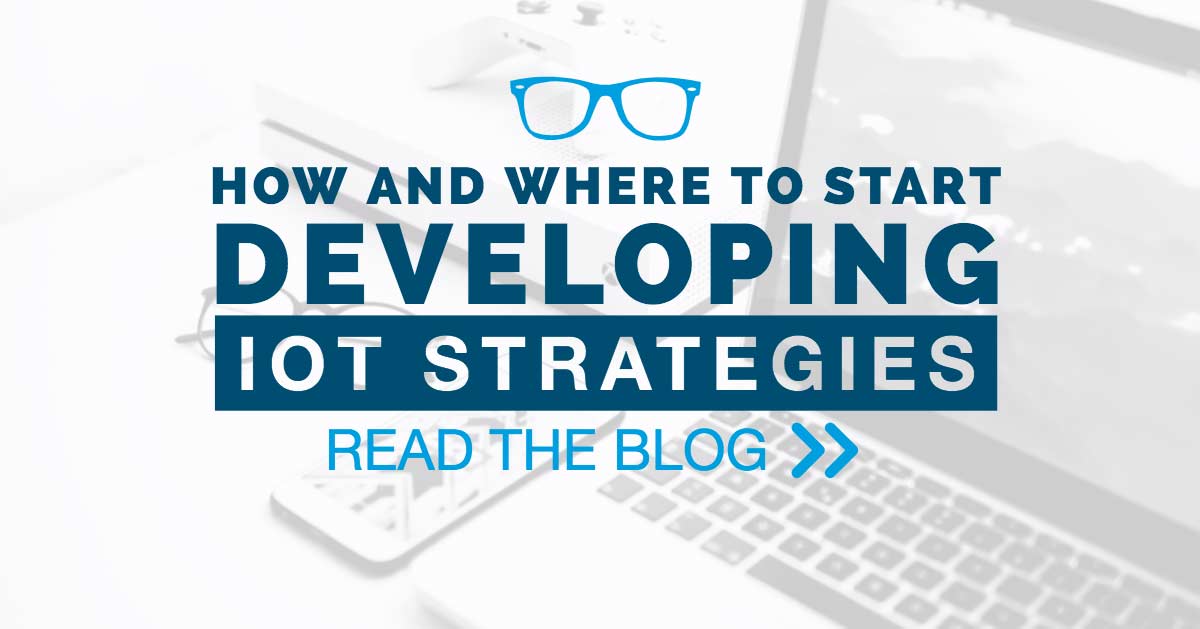AR and IoT are beginning to transform the way organizations are interacting in their industrial environments.
With the ability to integrate technology everywhere, products, processes, and people now have the ability to be connected like never before, allowing enterprises to drive product and service differentiation and promote operational effectiveness, workforce productivity, and unmatched quality.
Some might refer to this concept as the idea of digital transformation…but what does that really even mean? This article breaks it all down for you.
Digital Transformation with IoT and AR.
Today, innovative Augmented Reality tools have the ability to connect with powerful IoT data while working seamlessly in a service and training environment. With a mobile device or AR headset, technicians can easily learn to work in tandem drastically reducing training time and downtime simultaneously.
To better understand a concept of ‘digital transformation’, I’ll walk you through a real-life scenario involving one of our customers.
For this specific customer, the combination of AR and IoT has drastically improved the efficiency of their operations.
With the use of an AR application, our customer is able to provide their off-site workers with a digital model of one of their products immediately.
Placed alongside the digital model of their product, they are also able to see real-time data from the physical product that is off-site or working in the field.
This is possible because their AR experience also leverages a connection with their IoT platform, known as ThingWorx.
Their ThingWorx IoT platform connects to their disparate data systems, such as their ERP and CRM systems. It also connects to their PLM software, which provides them with the ability to pull a configuration from their PLM software, known as Windchill. This allows them to showcase unique product information, such as the VIN, model, customer and purchase information.
By having this data available and in context, remote technicians are better informed and empowered to make the best decisions possible.
As technicians launch their AR experience, they are able to see step by step instructions on how to repair or service the specific product.
They are also able to see warnings and replay steps that are integrated into the AR experience so they can be assured they are working in a safe environment without missing any procedures.
With the additional use of Vuforia Chalk, a remote video assistance app, employees are also able to instantly access remote subject matter experts or SMEs who can answer questions related to the experience and interact with the experience directly by drawing on the screen.
Finally, with time tracked throughout the experience, this service data can then be sent back to their ThingWorx IoT platform to assess performance, training, and to improve the CAD design leader.
By combining the use of AR and IoT, training and servicing is no longer hindered by traditional learning for our customer. Instead, their technicians are able learn from an experience that is enriched with data and context.
By leveraging ThingWorx, our customer is able to merge the digital and physical worlds of service providing their organization with an efficient and productive work environment.
This is the idea of digital transformation.
Curious how digital transformation might apply to your organization? We would love to have a conversation. Click the banner below to learn more.
The very definition of many industries is changing in no small part due to the of the Internet of Things (IoT) and its’ ability to disrupt and generate new business opportunities. Industry leaders across the board are starting to embrace IoT projects, use IoT devices, and build smart connected products using IoT platforms.
This article references real IoT case study stories and internet of things examples from John Deere and Nike to provide you with a better understanding of how the IoT is starting to shake up and disrupt industries.
To paint you a picture of exactly how the IoT is creating business opportunities for organizations today, let’s start with a company you might already be familiar with – John Deere.
Before the rise of IoT
John Deere has been making tractors and agriculture equipment for over 175 years.
For many years, though, they made simple tractors that weren’t ‘smart’ or connected products, they were just mechanical.
Soon enough, over time, John Deere’s products started to become smart and connected– changing everything for the organization.
Creating smart products & connecting devices
John Deere began to equip their products with digital dashboards, engine control units, sensors to alert users if they are running out gas, if oil pressure is too high, if hydraulic pressure is too low, etc.
By doing so, John Deere began to realize the countless benefits that came along with connecting their agricultural equipment to the internet of things, which eventually would provide the ability to remotely monitor the equipment’s performance.
Now remember, at this point, John Deer was still a tractor company, but as the organization moved forward with their vision of smart connected products, they also created what is called a smart connected product system.
The evolution of a smart connected product system & Digital Transformation
At the heart of John Deer’s product system is what is called a combine harvester. Their combine harvester harvests grain from fields, separates the head or the ear from the stalk, and divides the hulls, cobs, and the husks from the kernels of grain.
Today these smart connected combines have the ability to smartly monitor how many kernels came from a single patch of land, and how many kernels came from another.
In fact, they even collect, store, and send data to the cloud for the following season – so the machine is able to perform what is called a smart planting scheme.
During the smart planting scheme, the tractor hooks up to a tiler, which is basically a plow. As the plow works the soil, the equipment frequently fertilizes it, particularly with nitrogen. The equipment then follows its smart planting scheme – if the yield was low, nitrogen application should be high in a particular spot. If the yield was high, nitrogen should decrease.
Next from the connected product system comes the tractor pulling the planter that puts kernels in the ground for next year’s crop. It’s doing the same thing.
With a wide variety of seeds, the planter makes smart decisions for specific spots as needed. The smart connected equipment even knows when to use different drought resistant seeds in particular dry patches of land.
Smart products and the internet of things
John Deere created their own unique smart connected product system with the equipment they manufacture. By using smart connected devices, sensors, and building on top of an IoT platform, they slowly started to connect their entire product line.
This breakthrough in farming equipment enabled their products to work together and share data back and forth.
Farmers are now able to correlate their inputs and outputs, while reducing inputs and maximizing outputs. This means productivity and profits.
Taking it a step further, John Deere designed a smart farm system where, depending upon commodity prices, the equipment has the ability to plants different seeds.
Farms that irrigate now have the ability to place sensors in the soil to that read moisture levels. Using this knowledge, the smart equipment is able to determine whether it should apply more or less water to particular locations.
Agricultural equipment can now even assess upcoming weather forecasts and determine if irrigation is critical.
Today, John Deer is leading the way in utilizing IoT in agriculture.
New business opportunities with IoT
John Deere went from selling tractors to selling sophisticated information systems that can run smart farms.
With the technological advancements around today, a company like John Deere now has to determine the actual business they are in.
IoT presents new industry opportunity
Somewhere along the way, while developing smart connected products, John Deere became a software company and a systems integrator.
The internet of things presented John Deere with an opportunity to compete within an entirely new industry.
In fact, some say with this the new industry opportunity, John Deere even has the ability to compete with other well-known IT system integrators – such as Accenture.
The internet of things and smart connected products present a very interesting phenomenon, that’s happening right now.
Homes are beginning to transition to smart homes. Automobiles are starting to become smart. It’s happening everywhere you turn, even if in some cases it might be very subtly, or slow.
Products are evolving
Nike is another great example of how the IoT has started to accelerate and transform organizations.
Historically, Nike has made shoes, clothes and sunglasses – but today, their product line is now much more than that.
For Nike, it’s no longer just about clothes and shoes anymore. Their products have evolved from fitness equipment to fitness monitoring systems – driving personal health and wellness goals.

They too, started connecting their products by adding sensors into their shoes, clothes, and Fuel Bands. This has enabled their smart connected products to help people maintain physical fitness and health.
Businesses possibilities of IoT
With the real-world examples from John Deere and Nike, it’s easy see how businesses are starting to expand their industry boundaries with the internet of things.
The world is changing, smart connected products are continually evolving. What is your organization doing to stay ahead?
Explore the business possibilities of IoT for your organization
Organizations today are adopting valuable IoT solutions to lower operating costs, increase productivity, and develop new products.
The Internet of Things can offer your organization an opportunity to be more efficient whether its connecting devices with automated systems that gather information, analyzing IoT data, creating an action to learn from a process, achieving the pinnacle – remote control, support and maintenance.
We want to help you achieve your IoT objectives
Not sure what the advantages of IoT are for your organization? We would love to help you define and push your boundaries!
Our technology specialists are experts at devising what IoT solutions, devices, projects, and business models are best suited for your organization. Let’s have a conversation.
The internet of things and the capability to connect to the internet suddenly brings all kinds of new implications for products and their value.The internet of things is fundamentally changing how products function and how customers derive value from them.
How the internet of things is changing products and impacting what customers perceive as product value
Products today are becoming a combination of physical components, smart components, and connectivity components. Each of the 5 layers of the IoT stack plays a role — core product infrastructure, sensor systems, connectivity, analytics, and smart applications on an IoT platform.
While all three elements — Strategy, Connected Things, and true IoT platforms — seem somewhat elemental, balancing these will be central to the success of any IoT enabled business initiative.
For instance, look at a simple product, such as the light bulb.What is the product? In this case it’s the light bulb itself.What is the value of the product? I’m not talking about the monetary value, but rather the reason, need, or problem that drives the product purchase in the first place.
You might say in this specific case, the value of the product is the light that it provides, the illumination it creates, or perhaps the extension of functional hours it delivers.
What if we were to add connectivity to the product?By using an app on a device that controls the bulb via Bluetooth connection, you could now change the color of the light remotely.You could control the function of the light bulb with the sound of your voice.You could use the products new functionality to simulate the sunrise and replace your alarm.You could even sync the bulb to reflect your fluctuating stock prices! There’s a host of applications now available – just for a single light bulb.
Revisiting the original question, evaluating your new connected light, what is the product?Is it still just the bulb? What about the app that controls it, or the device that supports the application?It’s really an interesting question to consider.It’s really an interesting question to consider.For this same connected product, let’s talk about its value.
Again, I’m not talking the connected product’s monetary value, but rather the reason the product would be purchased in the first place.Would it still be just for the light or illumination, or is it the array of colors, new features and functionality?The fact of the matter is – the value of the product has changed.The connected product now adds value in the form of light, remote control, entertainment, and even overall experience.
Products and their value are changing
As a consumer shopping for an original bulb, you were most likely looking for a certain wattage or color (such as yellow or white) – not an experience.The connected product now adds value in the form of light, remote control, entertainment, and even overall experience.
Now that products are changing and you have systems of products: an app, a bulb, connectivity; the product value changes as well.You now have the ability to look for a light that can be synced to music or sound. A light that simulates the sunrise. A light that you can control from your device.You now need to weigh product value against a slew of new price points, features, and the support the manufacturer will provide over the years.
There’s no question that the value of products is changing because products themselves are changing. We’d like to help you map out this new world.If you’d like to do anything from brainstorm potential impacts to your business, develop a full strategy for IoT at your organization, create proof-of-concepts, or implement underlying technology… you’ve come to the right place.
We’re your partner in the ever-changing world of the internet of things.
The internet of things (IoT) is a business and technology revolution. It not only enables the connection and communication with ‘things’ but allows us to manage them.
It allows our organizations to do preventative and predictive maintenance on ‘things’, do guided service on ‘things’, and create digital twins of ‘things’. It enables us to improve operational efficiency, significantly reduce downtime, and to develop new revenue streams.
What makes up the ‘Internet’ in IoT?
The internet is composed of two separate communities; the internet of people and the internet of things or IoT.
The Internet of People
First, let’s break down what we mean by ‘the internet of people.’
The internet of people has grown organically over the past 20 years and has evolved into becoming an interconnected network of billions of people. That’s right, billions. Its primary purpose is to connect people, collate information, and enable people-to-people interaction.
The internet of people allows people to connect by becoming a clearinghouse of information. People post information available to other people, generating a great deal of information that is being pumped into the cloud.
The Internet of Things – IoT
The internet of things has been growing organically for the past 10 years and has the potential to become much larger than the internet of people. Its primary purpose is to connect machines, people, and data.
The IoT also enables people-to-machine and machine-to-machine interactions. In the Internet of Things, things are pumping data into the cloud so products can be monitored, controlled, optimized, and automated. During this process, information and data are streaming into the cloud from both people and things.
Combining the internet of people and things
This leads us to the internet. As mentioned earlier, the internet is the combination of internets of people and things into one integrated network. (Of course, they never were really separate, but it helps to think of them that way to facilitate the study of IoT).
Why are businesses investing in IoT?
The market for IoT is huge! Today there are over 20 billion connected devices, and that number is growing at an incredible pace. With connected devices comes a tremendous upside opportunity for IoT investments.
Through 2020, estimates are as high as 1.6 Trillion dollars! In fact, McKinsy has determined that the economic impact of IoT will top 11 Trillion dollars by 2025! The reason companies are starting to make such big investments in IoT is because so much value can be created.
How the Internet of Things is impacting product value
The internet of things isn’t about the internet – it’s all about the things. The things are what’s changing. The trend of smart connected things is really accelerating now that there’s a computer of sorts inside just about everything!
Today, according to the US government Census Bureau, there are about seven billion people on the planet Earth. About one-third of these people are connected to the internet with smartphones, tablets, and computers- yet in 2010 we hit an important milestone where there were more things connected to the internet than there were people on Earth This suggests these connected ‘things’ aren’t just smartphones, tablets, and computers anymore – they are fitness bands, thermostats, vehicles and more! This is where real innovation is happening.
Today, almost everything we have around us is capable of connecting. I’m talking about buildings, appliances, machinery, farms, hospitals, cities – all kinds of things. Now there’s a massive investment that is feeding this rapid expansion of the smart connected products – the internet of things solutions market. The IoT solutions market includes the smart connected things, the connectivity services, the software platforms and applications, the security, the analytics, and really everything related to smart connected products.

IoT Development Workshop
At EAC, we want to make sure you don’t miss out on any revolution with respect to potential capabilities that you can add to your products- while we also realize the importance of basing your IoT initiatives around your mission statement. That’s why we created what we call our IoT Development Workshop.
We have made it our mission to help guide organizations like yours to explore and embrace the uncertainty of the emerging IoT market.



